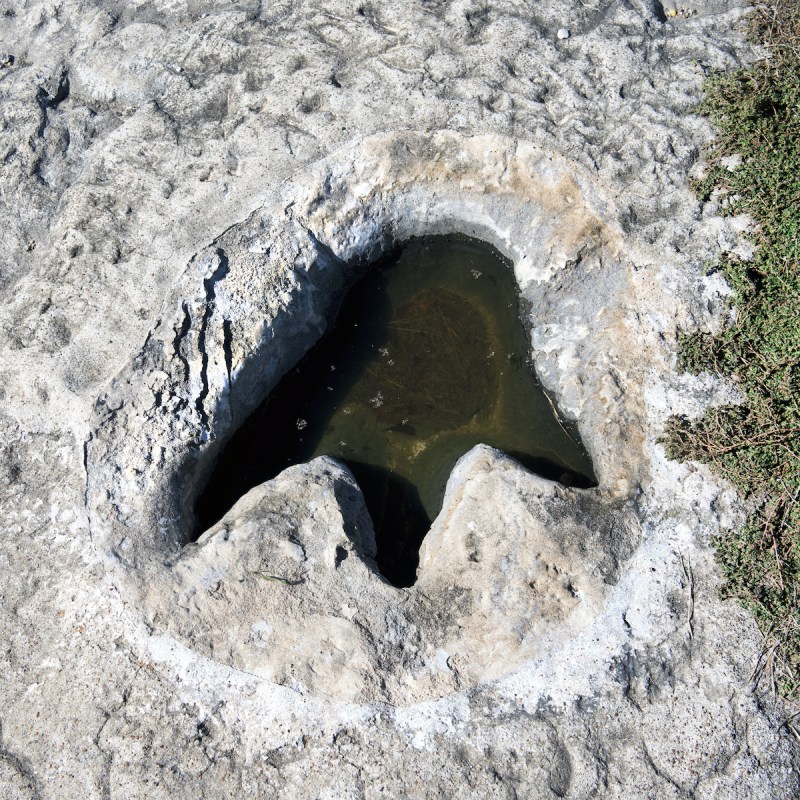
Dinosaur Valley State Park in Texas was already famous for its dinosaur tracks. Now, however, due to an ongoing widespread drought, the park’s riverbed has dried, revealing even more dinosaur tracks.
Videos by TravelAwaits
These tracks are estimated to be 113 million years old.
“Due to the excessive drought conditions this past summer, the river dried up completely in most locations, allowing more tracks to be uncovered here in the park,” said Stephanie Salinas Garcia, a Texas Parks and Wildlife Department spokesperson, according to Phys.org. “Under normal river conditions, these newer tracks are under water and are commonly filled in with sediment, making them buried and not as visible.”
The recently discovered tracks are called the “Lone Ranger trackway,” said Jeff Davis, park superintendent, according to BBC News. There are about 140 tracks from one dinosaur, and 60 of the tracks were visible when the riverbed dried and was exposed.
Volunteers from Dinosaur Valley State Park – Friends, a nonprofit that supports the park, have been cleaning mud and debris from the footprints of what they called “one of the longest dinosaur trackways in the world.” They also have been posting updates and pictures of the three-toed footprints to the group’s Facebook page.
Why The Tracks Were Found
The 1,587-acre Dinosaur Valley State Park, about an hour’s drive from Fort Worth, was once at the edge of an ancient ocean. Today, by walking along the Paluxy River, a tributary of the Brazos River, visitors can see dinosaur tracks left in the mud at the ocean’s edge.
“Calcium carbonate deposits from the shells of crustaceans such as crabs that lived in the sea formed a limey mud,” according to Texas Parks and Wildlife. “That mud had the perfect consistency — not too wet, not too stiff — to preserve tracks.”
In addition to numerous dinosaur tracks, the park also features a 70-foot-tall model of an Apatosaurus and a 45-foot-tall model of a Tyrannosaurus rex near its headquarters.
About The Newly Revealed Dinosaur Tracks
Most of the recently revealed tracks were made by an apex predator known as the Acrocanthosaurus, a carnivorous relative of the Tyrannosaurus rex that also walked on two legs.
Acrocanthosaurus, which weighed nearly 7 tons and were 15 to 20 feet tall, lived approximately 105 to 115 million years ago in the Early Cretaceous period.
Other newly revealed tracks in the park were made by Sauroposeidon, a long-necked herbivore. These dinosaurs, which were about 60 feet tall, weighed up to 44 tons.
Sauroposeidon has even been nicknamed “earthquake god lizard” due to its weight because the ground may have shaken when it walked by, according to New Dinosaurs.
Given Sauroposeidons’ size, it is unlikely adults would have been attacked by Acrocanthosaurus. However, some paleontologists hypothesize Acrocanthosaurus may have preyed on juvenile Sauroposeidon that hadn’t grown to their adult size yet.
While both sets of tracks are still visible, the reality is that rain will come again. When it does, sediment deposited by the river will once again help protect the tracks from weathering and erosion.
“While they will soon be buried again by the rain and the river, Dinosaur Valley State Park will continue to protect these 113-million-year-old tracks not only for present, but future generations,” Garcia said.
Know Before You Go
In addition to both the existing and newly revealed dinosaur tracks, Dinosaur Valley State Park is known for camping and its 20 miles of trails. Visitors typically picnic, hike, mountain bike, swim, fish, watch for wildlife, and even paddle in the river — when it isn’t dry.
You can learn more about Dinosaur Valley State Park here.
Be sure to also read about Dinosaur Valley State Park in 10 Fantastic Experiences At Dinosaur Valley State Park and 11 Fabulous State Parks In Texas’s Prairies And Lakes Region.
